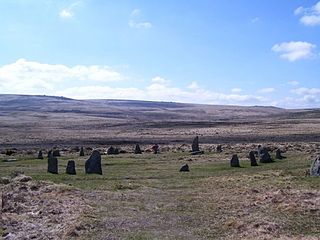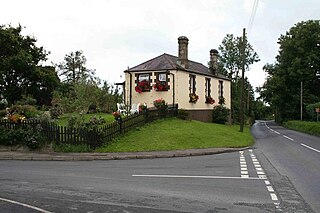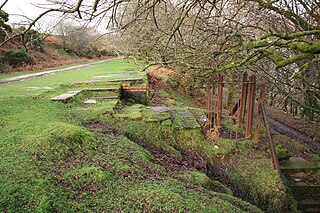
The industrial archaeology of Dartmoor covers a number of the industries which have, over the ages, taken place on Dartmoor, and the remaining evidence surrounding them. Currently only three industries are economically significant, yet all three will inevitably leave their own traces on the moor: china clay mining, farming and tourism.
Princetown is a village located within Dartmoor national park in the English county of Devon. It is the principal settlement of the civil parish of Dartmoor Forest.
William Crossing (1847–1928) was a writer and chronicler of Dartmoor and the lives of its inhabitants. He lived successively at South Brent, Brentor and at Mary Tavy but died at Plymouth, Devon.

Tavistock is an ancient stannary and market town within West Devon, England. It is situated on the River Tavy from which its name derives. At the 2011 census the three electoral wards had a population of 13,028. It traces its recorded history back to at least 961 when Tavistock Abbey, whose ruins lie in the centre of the town, was founded. Its most famous son is Sir Francis Drake.

Teignbridge is a local government district in Devon, England. Its council is based in the town of Newton Abbot. The district also includes the towns of Ashburton, Buckfastleigh, Dawlish, Kingsteignton and Teignmouth, along with numerous villages and surrounding rural areas. Teignbridge contains part of the south Devon coastline, including the Dawlish Warren National Nature Reserve. Some of the inland western parts of the district lie within the Dartmoor National Park. It is named after the old Teignbridge hundred.

Widecombe in the Moor is a village and large civil parish in Dartmoor National Park in Devon, England. Its church is known as the Cathedral of the Moors on account of its tall tower and its size, relative to the small population it serves. It is a favourite tourist centre, partly for its scenic character and partly for its connection to the popular song "Widecombe Fair".

Crazywell Pool or Crazy Well Pool is a large pond situated about 3 km (1.9 mi) south of Princetown just off the path between Burrator and Whiteworks on the western side of Dartmoor, Devon, England at grid reference SX582705. It is about 100 metres (110 yd) long and has a surface area of about 3,500 square metres.

The Erme is a river in south Devon, England. From its source on Dartmoor it flows in a generally southerly direction past some of the best-preserved archaeological remains on the moor. It leaves the moor at the town of Ivybridge and continues southward, passing the settlements of Ermington, Modbury and Holbeton. Near Holbeton it becomes a ria and empties into the English Channel in Bigbury Bay, between the rivers Yealm and Avon.

Bovey Tracey is a town and civil parish in Devon, England, on the edge of Dartmoor, its proximity to which gives rise to the slogan used on the town's boundary signs, "The Gateway to the Moor". It is often known locally as "Bovey". It is about 10 miles south-west of Exeter and lies on the A382 road, about halfway between Newton Abbot and Moretonhampstead. The village is at the centre of the electoral ward of Bovey. At the 2011 census the population of this ward was 7,721.

Burrator Reservoir is a reservoir on the south side of Dartmoor in the English county of Devon. It is one of a number of reservoirs and dams that were built over the course of the 19th and 20th centuries in the area now covered by Dartmoor National Park to supply drinking water to the city of Plymouth and other rapidly growing towns in the surrounding lowlands.

Iddesleigh is a village and civil parish in the county of Devon, England. The settlement has ancient origins and is listed in the Domesday Book. The village lies on the B3217 road, roughly central in its parish of around 2,900 acres (1,200 ha), about 8 miles (13 km) north of the town of Okehampton.

Sheepstor is a village, civil parish and former manor on the western side of Dartmoor in the county of Devon, England. In 2001, its population was 53, down from 95 in 1901. For administrative purposes the parish is grouped with the parishes of Meavy and Walkhampton to form Burrator Parish Council, and for electoral purposes it is grouped with the same two parishes to form Burrator Ward. Burrator Reservoir, constructed in 1898, is to the north of the village and forms part of the northern boundary of the parish.

The Princetown Railway was a 10¼ mile single track branch railway line in Devon, England, that ran from Yelverton on the Plymouth to Tavistock line, to Princetown via four intermediate stations, Dousland, Burrator and Sheepstor Halt, Ingra Tor Halt and King Tor Halt. The line closed in 1956 and today forms part of a popular cycling and walking route.

War Horse is a 2011 war drama film directed and produced by Steven Spielberg, from screenplay written by Lee Hall and Richard Curtis. It is based on Michael Morpurgo's 1982 novel of the same name and its 2007 stage adaptation. The film features an ensemble cast that includes Peter Mullan, Emily Watson, Niels Arestrup, Jeremy Irvine, David Thewlis, Tom Hiddleston and Benedict Cumberbatch. Set before and during World War I, its plot follows Joey, a bay Irish Hunter horse raised by British teenager Albert as he is bought by the British Army, leading him to encounter various people throughout Europe, in the midst of the war and its tragedies.

The Dartmoor Yomp is an annual charitable fundraising event run in aid of the various charities that support injured British Armed Forces Royal Marines. The Yomp is a daytime trek held in the Dartmoor National Park in the county of Devon, England, usually some 12 miles (19 km) in length, and is undertaken by disabled servicemen joined by able-bodied former and serving Royal Marines and their immediate families. The challenge is usually held over two days in September: a get-together on the Friday and the actual Yomp on the Saturday. The Dartmoor Yomp takes its name from the Royal Marines slang term "yomp", meaning a route march carrying full kit. It was founded in 2008.

ScorhillStone Circle is now the commonly known name for Gidleigh Stone Circle or Steep Hill Stone Circle, one of Devon's biggest and most intact stone circles, situated on Gidleigh Common near the village of Gidleigh in the north east of Dartmoor, in the United Kingdom. It is an English Heritage scheduled monument and has been described as Devon's finest stone circle.

Dousland railway station, originally opened at Dousland Barn in 1883 was located on the 10.5 mile long single track branch railway line in Devon, England, running from Yelverton to Princetown with eventually four intermediate stops, three being halts and one at Dousland as a fully fledged station.
Princetown railway station, opened in 1883 was the terminus of the 10.5 mile long single track branch line in Devon, England, running from Yelverton with eventually four intermediate stops, three being halts and one at Dousland as a fully fledged station.

Burrator and Sheepstor Halt railway station was located on the 10.5 mile long single track branch railway line in Devon, England, running from Yelverton to Princetown with eventually four intermediate stations. The station was opened as Burrator Platform and became Burrator Halt when it was opened to the public, the name being changed again in 1929 to Burrator and Sheepstor Halt.




















